|
Chinese Ivory Carvings
By Isadore M. Chait
Posted June 2012
While the subject of this article is Chinese ivory carvings, we must first look at “What is ivory?” Ivory is a tooth or teeth. It is the dentine matter of all mammals, whether land-dwelling or marine. The primary list of animals associated with ivory are: the elephant (both African and Asian varieties), walrus, hippo, boar and various species of whales (especially the narwhal). I could go on and include various other teeth that have been used for ornamentation such as elk, tigers, etc. Wherein humans the canine teeth are relatively short, in other mammals, they grow or can grow quite long.
Elephant tusks frequently are six or seven feet long. Ice Age mammoth tusks are quite often much longer than that. Narwhal tusks (of which only one grows long and in a spiral) can grow six to eight feet and were the basis of many legends concerning the unicorn. Walrus tusks often are three feet in length. Much more can be said, but suffice it to say that the most common ivory material that is carved comes from the elephant. It is also interesting to note that, in creatures that have pairs of tusks, one is always a bit longer.
We can now go into the history of ivory carving, which dates back to prehistoric times. Ivory has always been a treasured object in China and Asia from which to create carvings. Ancient Russians carved fossil ivory that they found in Siberia as did the ancient Norse and those related peoples. Alaskan and Greenland Eskimos carved ivory that was available to them, which included walrus tusks and whale’s teeth. New England whalers engraved into whale’s teeth and inked the engraving, which became known as scrimshaw. South Pacific Islanders carved whale’s teeth and the tusks of wild boar into ornamental jewelry. Africans carved both elephant ivory and hippo tusks into portrait objects and narrative carvings. Again, I could go on and on as the subject is boundless.
Now here is where a certain amount of connoisseurship is necessary to differentiate quality of carving. This, of course, is an aesthetic viewpoint, but since we all nowadays think about value as significant, it becomes a viewpoint that has to be considered. Value, of course, is based upon three primary factors: material, workmanship and age. In ivory, the material should be relatively solid and relatively unblemished. The upper portion of a tusk, no matter what animal, is the most solid because, as we know, tusks and teeth alike have pulp, blood vessels, nerves, etc., which occupy a portion of the tusk or tooth where it fit into the jaw. For example, in a long elephant tusk, that portion can often occupy a third of the length of the tusk and make that third hollow, as it narrows into that more solid portion.
As far as workmanship goes, the most precise and highest quality of detailing and exactness can be generally found on European ivories of the 17th, 18th and 19th centuries, but these are quite scarce. Exacting details can also be found in Japanese carvings, which can be large, medium or quite small, as exemplified by the most intricate netsuke. The most common, plentiful and at this point, most collectible carvings in ivory are produced in China. Ivory was not an uncommon material used in early Dynastic China 2,000 years ago, but it came into its own during the Ming Dynasty (16th/17th centuries). These ivories, while not plentiful, still can be found, and all through the centuries, copies have been made.
Let us look at the subject of age, which in ivory is not instantly identifiable. Because the material is organic, it does respond to the elements, which can give signs of age. For example, a carving exposed to light on one side and not on the other will change color, going lighter on the side exposed to light and darker on the side not exposed. Also since it is organic, ivory contains water, and when dry, the surface can start to craze. If too dry, the whole piece can crack. Unfortunately, this also lends itself toward artificial aging in that ivory can be stained, which it quite often is, or bleached, or lacquered, or polychromed or have its surface dried so it has the appearance of having hundreds of years of age, where it only has dozens of years.
Now here is the good news. Chinese ivory carvings have value and are highly collectable, whether antique or not. Of course, if actually antique, they can be quite expensive and quite difficult to find. Good examples of antique carvings are illustrated in the world famous volumes representing the Sasoon Collection, but wonderful examples can also be found quite readily from the early- to mid- 20th century. In reality, quite wonderful carvings are currently being manufactured in China, especially in Beijing and Guangzhou (Canton) and also in Hong Kong. Unfortunately, some of these modern carvings cannot leave China due to international conventions on the importation and trade of endangered species (CITES). Fortunately, many of these carvings are executed in fossil ivory (mammoth tusk). Fossil ivory, of course, is not prohibited to be imported nor exported as these animals died naturally thousands or many tens of thousands of years ago.
This brings us to a whole new subject that concerns itself with ivory and the law: you can own ivory. You can collect it. You can buy it, and you can sell it. You can inherit a collection. You just cannot bring ivory into the USA or export it out of the USA, unless it is either antique (more than 100 years old) or pre-ban (pre-Convention).
Fortunately, the most common kinds of carvings that you will find are those of African elephant ivory. These elephants are protected and on various wildlife-threatened lists, but they are not usually considered endangered; so if you follow the rules, you will be safe in collecting these objects.
Asian elephant ivory is another story, in that these elephants are endangered, and ivory from them can be highly restricted, unless the pieces are truly antique. The same holds true for marine ivory, which can only be hunted and worked by native peoples who live where these animals exist.
| 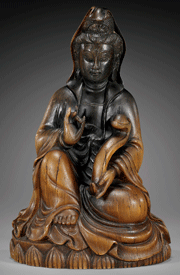
|
Finely carved rhinoceros horn figure of Guanyin (an enlightened person associated with compassion or a goddess of mercy) holding a ruyi scepter in her right hand, dressed in hooded robes, the horn ranging from deep brown to honey and caramel tones; 6.75 inches high; sold for $190,000.
|
It is turning out that the Chinese themselves, whether residents of China or overseas, are quickly becoming the biggest collectors of Chinese ivory carvings. It also has turned out that age is making less and less of a difference in value, and workmanship seems to be the primary criteria upon which value is judged. This makes it a lot easier for all of us to take a piece of Chinese-carved ivory, look at the quality of workmanship and whether it’s actually antique or just early- to mid- 20th century, and then quickly come up with an evaluation.
Now, of course, there are other factors that matter as to the value. Size matters. It matters if a piece is carved out of one whole section of tusk or sectional and put together. It matters what the subject matter is. Given two comparable-size and comparable-quality pieces, a Guanyin (Buddhist goddess of mercy) will be much more collectable than an ordinary figure. Fortunately, these are all factors that can be easily learned by watching auction sales and seeing what’s more collectable and what’s not.
Now we run into more liabilities connected with the collection of ivory. Still made today and made on and off in the last five or six decades are polymer-resin pieces made to look like ivory. Many are made in Italy. Even in the 1920s, ivorine (a synthetic ivory-like resin) was made into parts of ladies’ dressing sets. They even made the pieces with simulated growth lines.
Animal bone is also very frequently mistaken and presented to people as ivory, as it can be carved in similar forms and frequently colored or polychromed to look like ivory carved during the Cultural Revolution Period. Then, of course, we have some dealers with less integrity and honesty than others.
Maybe part of the public’s distaste for ivory can be justified because of the media’s sensationalizing the poaching of animals in Africa. This obviously prompted sales platforms, such as eBay, to ban the offering of ivory, but if you go to eBay and look up cow bone, you will see that most of what’s being referred to as “cow bone” is actually ivory. Why do these double standards continue? That’s one I am still trying to figure out.
For those of you who are interested in ivory, it is a fascinating material. It can be legally acquired. The workmanship can be a pleasure to behold, and if you don’t take offense at the history of where the material comes from, it is a field of collecting that can have great appreciation in the future. If the idea of one of these wonderful creatures being killed for its tusks is even remotely unpleasant to you, even if the event occurred many decades ago, the solution is to collect fossil ivory carvings. The quantity of them is quite plentiful, and they exhibit the same quality of detail as any other ivory material would have.
---------------------------
Isadore M. Chait is a licensed auctioneer in the State of California and for decades has been holding the only monthly auctions in Southern California devoted to Asian Fine Arts. According to Architectural Digest, "Isadore Chait, specialist in Oriental sculpture and expert in gemology, has developed a world-wide reputation among museums and collectors and is frequently consulted by both groups for authentication, market value and appraisals." He is a recommended appraiser for many museums and universities, including the J. Paul Getty Museum, the Norton Simon Museum, the Los Angeles County Museum of Art, the University of California at Los Angeles, and the Claremont University Center. In the past three decades, he has been to China over 100 times. During the last four decades, he has been professionally evaluating, authenticating, buying and selling Asian antiques and antiquities.
|
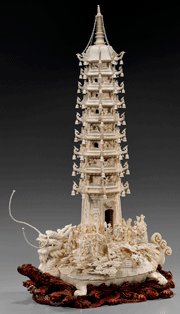
Intricately detailed, sectional ivory of a mythological dragon-turtle with numerous Immortals amid clouds on its back, surmounted by an Imperial-style, eight-tiered pagoda with bells and figures on all the balconies, topped by a lotus-motif spire with loose chains; 32.5 inches high; sold for $15,000.

A 42-inch tall Shou-lao (deity of longevity) figure with a gnarled staff, branch of peaches and deer at his feet; sold for $13,000.
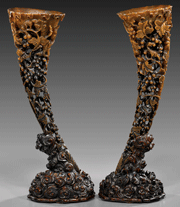
Pair of Chinese rhinoceros horns carved in the form of libation vessels with squirrels amid grape vines, leaves and clusters of fruit; 19.25 inches; sold for $220,000.
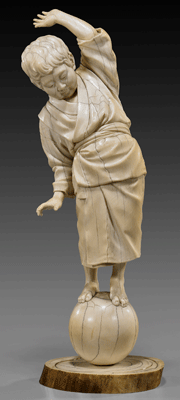
Antique Japanese Tokyo School ivory figure of a boy balancing on a ball; attributed to Yoshida Homei; 14.25 inches high; sold for $5,500.
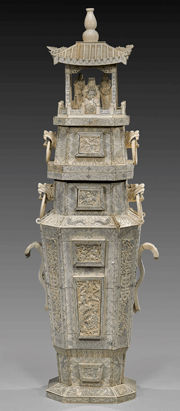
Massive 56-inch-high, covered urn, sectional and appliqué, carved with warrior figures, court scenes, dragon, phoenix and three officials on top; sold for $7,500.
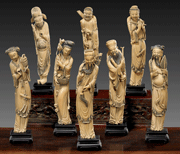
Standing figures representing the Eight Immortals, each carrying his or her own attributes, one with separate flute; 13-14 inches high; sold for $25,000.
|